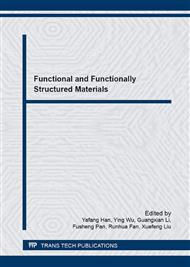[1]
B. Jaffe, R.S. Roth, S. Marzullo, Piezoelectric Properties of Lead Zirconate-Lead Titanate Solid-Solution Ceramics, J. Appl. Phys. 25 (1954) 809-10.
DOI: 10.1063/1.1721741
Google Scholar
[2]
J. Rödel, W. Jo, K.T.P. Seifert, E.M. Anton, T. Granzow, D. Damjanovic, Perspective on the development of lead-free piezoceramics, J. Am. Ceram. Soc. 92 (2009) 1153-1177.
DOI: 10.1111/j.1551-2916.2009.03061.x
Google Scholar
[3]
Y. Saito, H. Takkao, T. Tani, T. Nonoyama, K. Takatori, T. Homma, T. Nagaya, M. Nakamura, Lead-free piezoceramics, Nat. 432 (2004) 84-87.
DOI: 10.1038/nature03028
Google Scholar
[4]
J.F. Li, K.W., F.Y. Zhu, L.Q. Cheng, F.Z. Yao, (K, Na)NbO3-Based Lead-Free Piezoceramics: Fundamental Aspects, Processing Technologies, and Remaining Challenges, J. Am. Ceram. Soc. 96(2013) 3677-3696.
DOI: 10.1111/jace.12715
Google Scholar
[5]
Y.P. Guo, K.I. Kakimoto, H. Ohsato, Phase transitional behavior and piezoelectric properties of Na0. 5K0. 5NbO3-LiNbO3 ceramics, Appl. Phys. Lett. 85 (18) 4121-23.
DOI: 10.1063/1.1813636
Google Scholar
[6]
Y.P. Guo, K.I. Kakimoto, H. Ohsato, (Na0. 5K0. 5)NbO3-LiTaO3 lead-free piezoelectric ceramics, Mater. Lett. 59 (2005) 241-4.
DOI: 10.1016/j.matlet.2004.07.057
Google Scholar
[7]
G.Z. Zang, J.F. Wang, H.C. Chen, W.B. Su, C.M. Wang, P. Qi, B.Q. Ming, J. Du, L.M. Zheng, S.J. Zhang, T.R. Shrout, Perovskite (Na0. 5K0. 5)1−x(LiSb)xNb1−xO3 lead-free piezoceramics, Appl. Phys. Lett. 88 (2006) 212908.
DOI: 10.1063/1.2206554
Google Scholar
[8]
S.J. Zhang, R. Xia, T.R. Shrout, G.Z. Zang, J.F. Wang, Piezoelectric properties in perovskite 0. 948(K0. 5Na0. 5)NbO3-0. 052LiSbO3 lead-free ceramics, J. Appl. Phys. 100 (2006) 104108.
DOI: 10.1063/1.2382348
Google Scholar
[9]
D.M. Lin, K.W. Kwok, K.H. Lam, H.L.W. Chan, Phase structure and electrical properties of K0. 5Na0. 5(Nb0. 94Sb0. 06)O3-LiTaO3 lead-free piezoelectric ceramics, J. Phys. D-Appl. Phys. 41(2008) 052002.
DOI: 10.1007/s00339-007-4391-0
Google Scholar
[10]
V.J. Tennery, K.W. Wang, Thermal and X-Ray Diffraction Studies of the NaNbO3-KNbO3 System, J. Appl. Phys. 39(1968) 4748-53.
Google Scholar
[11]
R. Zuo, J. Fu, D. Lv, Phase Transformation and Tunable Piezoelectric Properties of Lead-Free (Na0. 52K0. 48-xLix)(Nb1-x-ySbyTax)O3 System, J. Am. Ceram. Soc. 92 (2009) 283-285.
Google Scholar
[12]
X. M. Pang, J. H. Qiu, K. J. Zhu, Y. Cao, Effects of Sb content on electrical properties of lead-free piezoelectric (K0. 4425Na0. 52Li0. 0375) (Nb0. 9625-xSbxTa0. 0375)O3 ceramics, Ceram. Int. 38 (2012) 1249-1254.
DOI: 10.1016/j.ceramint.2011.08.056
Google Scholar
[13]
R. Muanghlua, S. Niemcharoen, M. Sutapun, B. Boonchom, N. Vittayakorn, Phase transition behaviour and electrical properties of lead-free (K0. 5Na0. 5)NbO3-LiNbO3-LiSbO3 piezoelectric ceramics, Curr. Appl. Phys. 11 (2011) 434-437.
DOI: 10.1016/j.cap.2010.08.015
Google Scholar
[14]
Q. Zhang, B. P. Zhang, H. T. Li, P. P. Shang, Effects of Sb content on electrical properties of lead-free piezoelectric [(Na0. 535K0. 480)0. 942Li0. 058](Nb1−xSbx)O3 ceramics, J. Alloy. Comp. 490 (2010) 260-263.
DOI: 10.1016/j.jallcom.2009.09.172
Google Scholar
[15]
X. Vendrell, J.E. García, F. Rubio-Marcos, D.A. Ochoab, L. Mestres, J.F. Fernández, Exploring different sintering atmospheres to reduce nonlinear response of modified KNN piezoceramics, J. Euro. Ceram. Soc. 33 (2013) 825-831.
DOI: 10.1016/j.jeurceramsoc.2012.09.025
Google Scholar
[16]
Y. Wang, D. Damjanovic, N. Klein, N. Setter, High-temperature instability of Li- and Ta-modified (K, Na)NbO3 piezoceramics, J. Am. Ceram. Soc. 91(2008)1962-70.
DOI: 10.1111/j.1551-2916.2008.02392.x
Google Scholar
[17]
S.J. Park, H.Y. Park, K.H. Cho, S. Nahm, H.G. Lee, D.H. Kim, B.H. Choi, Effect of CuO on the sintering temperature and piezoelectric properties of lead-free 0. 95(Na0. 5K0. 5)NbO3-0. 05CaTiO3 ceramics, Mater. Res. Bull. 43 (2008) 3580-56.
DOI: 10.1016/j.materresbull.2008.01.015
Google Scholar
[18]
K. Wang, J. F Li, (K, Na)NbO3-based lead-free piezoceramics: Phase transition, sintering and property enhancement, J. Adv. Ceram. 1 (2012) 24-37.
DOI: 10.1007/s40145-012-0003-3
Google Scholar


